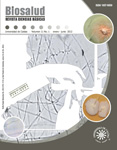Authors
Abstract
Stress is defined as "the action of nervous and emotional stimuli provoked by the environment on the nervous, endocrine, circulatory and digestive systems of an animal, producing measurable changes on the functional levels of these systems" (1). The goal of this work was to determine the resverasor antioxidant effect through the superoxide dismutase (SOD) enzymatic activity in the rats erythrocyte, and to correlate it with the reproductive parameters, number of corpora lutea (CL). and postimplantation survival (PS). Forty-eight female and 16 male three months old rats of the Wistar strain, were used, kept in a controlled environment, 20±2°C temperature and light-dark cycles of 14 and 10 h, respectively. The animals were fed a balanced diet and they had free access to water. Rats were divided in four groups at random: group 1 was treated with 5 ACTH i.p. ug/kg every 12 h; group 2 received the same ACTH treatment plus a 40 mg/kg oral grape extract supplement; group 3 received only the grape extract, and the last group served as control group and received oral i.p saline solution . The experimental design was 2×2 factorial, with two ACTH levels and two grape extract levels. At the end of the experiment female rats were sacrificed to extract the reproductive tract and determine the number of CL and fetuses. It was observed that the resverasor dose used did not affect erythrocyte SOD activity or reproductive performance measured in terms of CL and PS in rats treated with ACTH and grapes. This indicates that, possibly, rats adapted to chronic stress, and in consequence, to oxidative stress.
Keywords
References
Almier M, De Rosa G, Grasso F, Napolitano F, Bordi A. Effect of climate on the response of three oestrus synchronization techniques in lactating dairy cows Anim Rep Sci 2002; 71:157-68.
Magiakou MA, Mastorako G, Webster E, Chrousos GP. The hypothalamic-pituitary-adrenal axis and the female reproductive system. Ann NY Acad Sci 1997; 816:42-56.
Vélez-Marín M, Uribe-Velasquez LF. ¿Cómo afecta el estrés calórico la reproducción? Biosalud 2011; 9:83-95.
Goppelt Struebe M. Molecular mechanisms involved in the regulation of prostaglandin biosynthesis by glucocorticoids. Biochem Pharmacol 1997; 53:1389-95.
Colitti M, Sgorlon S, Stradaioli G, Farinacci M, Gabai G., Stefanon B. Grape polyphenols affect mRNA expression of PGHS-2, TIS11b and FOXO3 in endometrium of heifers under ACTH-induced stress. Theriog 2007; 68:1022-30.
Niswender GD, Juengel JL, Silva PJ, Rollyson MK, Mcintush EW. Mechanisms controlling the function and life span of the corpus luteum. Physiol Rev 2000; 80:1-29.
Kawate N, Inaba T, Mori J. Changes in plasma concentrations of gonadotropins and steroid hormones during the formation of bovine follicular cysts induced by the administration of ACTH. J Vet Med Sci 1996; 58:141-4.
Dobson H, Ribadu AY, Noble KM, Tebble JE, Ward WR. Ultrasonography and hormone profiles of adrenocorticotrophic hormone (ACTH)-induced persistent ovarian follicles (cysts) in cattle. J Reprod Fertil 2000; 120:405-10.
Dobson H, Fergani C, Routly JE, Smith RF. Effects of stress on reproduction in ewes, Anim Rep Sci 2012. [In press].
Tilbrook AJ, Turner AI, Clark IJ. Effects of stress on reproduction in non-rodent mammals: the role of glucocorticoids and sex differences Rev Reprod 2000; 5:105-13.
Harborne JB. Methods in Plant Biochemistry, In: plant phenolics. London: Academic Press; 1989.
Infante R. Polifenoles del vino y oxidabilidad de las lipoproteínas. ¿Blanco o tinto? Clin Invest Arterioscl 1997; 91:9-22.
Ministerio De Protección Social. Resolución 8430 Por la cual se establecen las normas científicas, técnicas y administrativas para la investigación en salud. Colombia; 1993.
Universidad de Caldas. Resolución Rectoral N° 000259. Por la cual se crea el comité de ética para la experimentación con animales; 2008, Mar 31.
Cammack KM, Mesa H, Lamberson WR. Genetic variation in fertility of heat-stressed male mice. Theriog; 2006; 66:2195-201.
Kairisalo M, Bonomoa A, Hyrskyluotoa A, Mudòb G, Belluardob N, Korhonena L, et al. Resverasor reduces oxidative stress and cell death and increases mitochondrial antioxidants and XIAP in PC6.3-cells. Neurosci Lett 2011; 488:263-6.
St-Pierre J, Drori S, Uldry M, Silvaggi JM, Rhee J, Jager S, et al. Suppression of reactive oxygen species and neurodegeneration by the PGC-1 transcriptional coactivators. Cell 2006, 127:397-408.
Paśko P, Bartoń H, Zagrodzki P, Chłopicka J, Iżewska A, Gawlik M, et al. Effect of amaranth seeds in diet on oxidative status in plasma and selected tissues of high fructose-fed rats. Food Chem 2011; 126:85-90.
Patra RC, Swarup D. Effect of antioxidant ascorbic acid, l-methionine or α tocopherol alone or along with chelator on cardiac tissue of lead-treated rats. Veterinarski Arhiv 2004; 74:235-44.
Conner EM. Grisham M.B. Inflammation, Free Radicals, and Antioxidants. Nutrition 1996; 12: 274-7.
Woung WY, Thomas MGL, Merkus MWM, Zielhueis GA. Steegers-Theunissen RPM. Male factor subfertility: possible causes and the impact of nutritional factors. Fertil Steril 2000; 73: 435-42.
Saleh RA, Agarwal A. Oxidative stress and male infertility: from research bench to clinical practice. J Androl 2002; 23:737-52.
Holland MK, Storey BT. Oxygen metabolism of mammalian spermatozoa. Generation of hydrogen peroxide by rabbit epididimal spermatozoa. Biochem J 1981; 198:273-80.
Céspedes EM, Reyes A. Marcadores de estrés oxidativo en ratas senescentes. Rev Cubana Invest Bioméd 2007; 26(2).
Mora H, Ángela C, Aragón Diana M, Ospina G. Luis F. Caracterización del estrés oxidativo en ratas wistar diabéticas por estreptozotocina. Vitae 2009; 16:311-9.
Gil PV, Schäfer F, Machado T, Almeida MF, Ramos P, Krumberg A, et al. Oxidative stress in the brain of reproductive male rats during aging. Exp Gerontol 2011; 46:241-8.
Mourlon V, Naudon L, Giros B, Crumeyrolle Arias M, Daugé V. Early stress leads to effects on estrous cycle and differential responses to stress. Physiol Behav 2011; 102:304-10.
Wiersma P, Selman C, Speakman J, Verhulst S. Bird sacrifice oxidative protection for reproduction. Proc R Soc 2004; 271:360-3.
Dalla C, Antoniou K, Drossopoulou G, Xagoraris M, Kokras N, Sfikakis A, Daifoti Z. Chronic mild stress impact: Are females more vulnerable? Neuroscience 2005; 135:703-71.
Romero MH, Uribe-Velásquez LF, Sánchez JA. Biomarcadores de estrés como indicadores de bienestar animal en ganado de carne. Biosalud 2011; 10:71-87.

 PDF (Español)
PDF (Español)
 FLIP
FLIP














